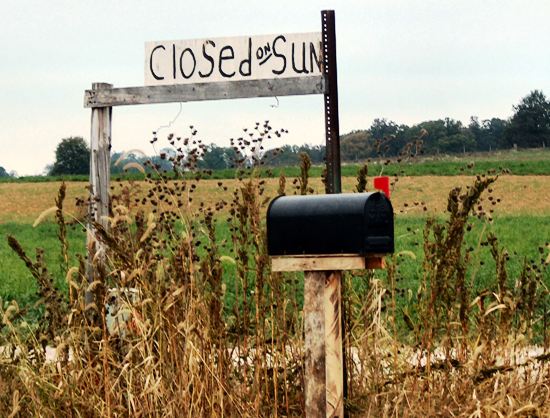A Look At Amish In Two Distant Corners: Vermont & Kansas
A quick look at a couple of communities in the more distant corners of Amish America. First, Bonnet Strings author Saloma Furlong gives an update on the Amish community near Brownington, Vermont via her blog.

Vermont photos: Mike Dougherty/VTDigger
Amish moved there in 2015, making Vermont the second New England state with a community. In 2018 there was talk of a second settlement possibly starting, but it doesn’t look like that has ever materialized. Here’s what Saloma learned on her visit to Brownington:
We also spent a good bit of time driving around the countryside. It felt strange to see horse and buggy signs near Lake Willoughby. I wrote about the first Amish families arriving in Vermont in a former blog post. David and I stopped at a veggie stand at an Amish farm. I asked how many families were living in the area, and the farmer said eighteen. I asked what brought them to the area, and he said farm land, and they thought that they area might support them. I asked if that has been the case, and he shrugged his shoulders this way and that. Then he said that there is one store that starting buying several kinds of vegetables from them, but indicated the support is slow in coming.
It’s a plain-leaning group:
Several daughters walked out of the barn in their bare feet, even though it was cold enough that they were wearing coats. The style of coverings and mode of dress indicated that this is a conservative group. When I spoke to the father of the first family to settle there a few years ago, I found they were from a daughter settlement of the community in Conewango Valley of New York state. That is indeed a conservative group. An uncle, an aunt, and their families lived there when I was growing up.

Vermont photos: Mike Dougherty/VTDigger
Have you ever had this experience which Saloma had at an Amish farm? While many Amish-produced things are good buys…just because it’s from the Amish, doesn’t mean it’s guaranteed to be top quality:
I also noticed that the veggies and the cantaloupe we bought were not very fresh. Without signs on the main roads, I imagine the people who find their way to this farm on a dirt road are few and far between.
I have to wonder if these Amish families will stay in Vermont. With a shorter growing season, I can imagine it would be hard to eke out a living by farming in the thin soil of Vermont. Some years ago I predicted that the Amish would find their way to the state of Vermont. Now I am not predicting whether they will stay or move. Only time will tell.
So if it’s the case that it’s a bit tougher to make a living in that area, maybe this community won’t be around five years from now. On the other hand, it might just be the way of things in this plain settlement. More conservative Amish tend to have lower incomes, and can make a go of it just fine living in conditions that “higher” Amish would find little appealing.
Second, the author of a blog called Hammock in the Woods paid a visit to Yoder, Kansas. We last really looked closely at Yoder back in 2014 via a guest post by Tom Geist. Besides having perhaps the most “Amish” name of any settlement, this is the oldest community in a state where Amish have long had a presence, but have never lived in especially great numbers. The 137-year-old community is just three churches in size today.

Anna Borntrager’s Country Variety Store. Photo by Tom Geist
Most of the post is about shops to visit in the town of Yoder, including what appear to be Amish businesses, like Yoder Meats and Yoder Furniture. There is not a lot on the Amish themselves; the most noteworthy thing I found in the post is this photo, in which we see what looks like a woman in a kapp driving a tractor down the road:

Photo: Hammock in the Woods
The post author writes:
If you visit Yoder, Kansas, you’re apt to see a bonnet-clad woman navigating a tractor along the main street, you’re apt to enjoy some delicious home-cooked foods, you’re apt to wind up in conversations with friendly residents.
This is a community which does use tractors as transport. On the earlier post, Tom Geist wrote that “What stood out the most for me was the use of tractors here. I saw several of the Amish people riding their tractors around town in Yoder like others use their buggies.”
Another place like this community in their tractor use is the settlement at Guthrie, Kentucky. You see buggies parked at Amish residences there…but they are mainly used for church on Sundays.
It’s another reminder of the stark differences in technology on the edges of the “Old Order Amish” category. On the one hand you’ve got groups which zip around in modern tractors not too unlike motor vehicles…and on the other, plodding open-front buggies with little in the way of markings beyond an oil lamp and meager reflective tape.
If you’d like to share your Amish community visit with the site, just drop me an email at ewesner[at]gmail[dot]com.









Buyer Be Aware
As stated in the article: “While many Amish-produced things are good buys…just because it’s from the Amish, doesn’t mean it’s guaranteed to be top quality.” Also, not all items that are designated “Amish Made” or businesses that state they’re Amish actually are.
As I’ve stated numerous times, there are good and bad Amish as there are good and bad English. Neither Amish or English should be put on a pedestal.
Buyers need to always be aware.
Well said, Pat!